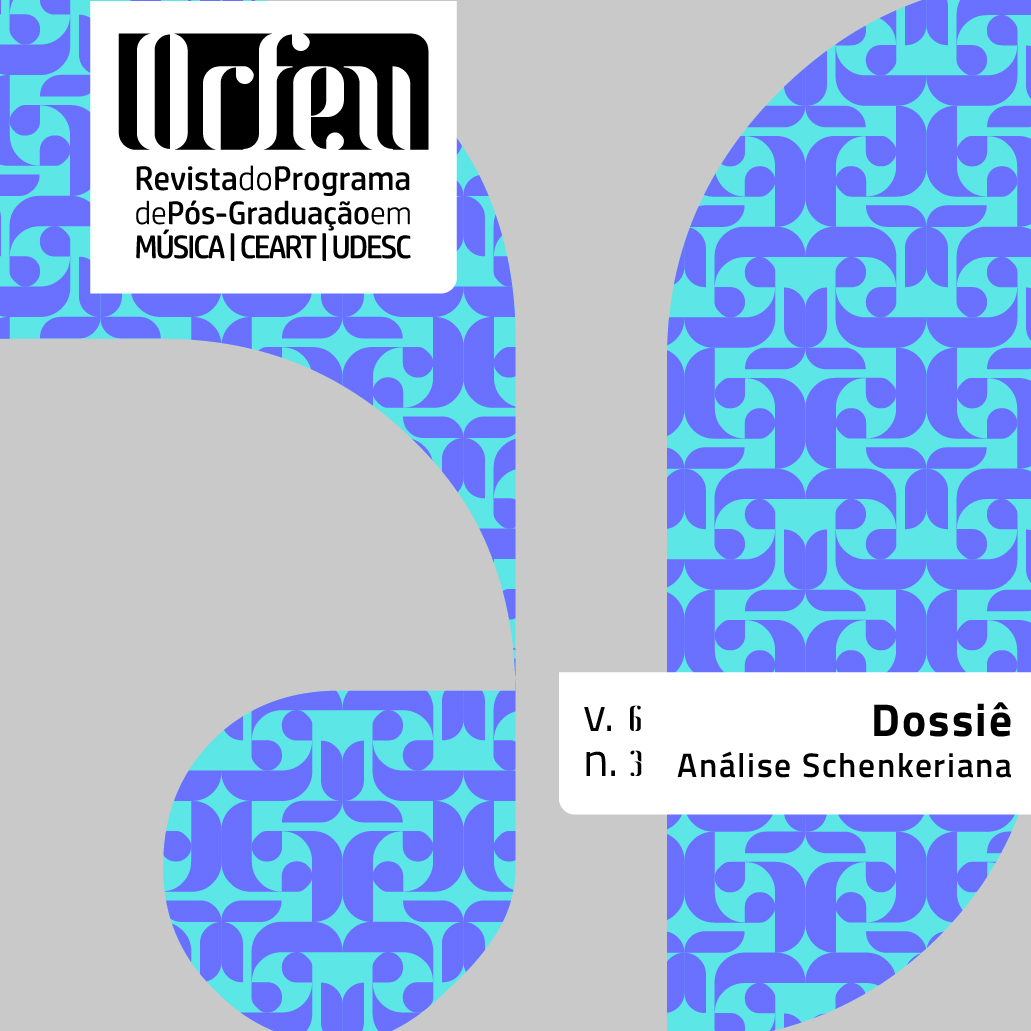Relações de simetria na estrutura de Eu te amo, de Antonio Carlos Jobim e Chico Buarque de Holanda
DOI:
https://doi.org/10.5965/2525530406032021080Parole chiave:
Simetria intervalar, Jobim e Chico Buarque, Análise Schenkeriana em música popular, Relação texto e músicaAbstract
Este artigo propõe uma análise detalhada da estrutura de alturas da canção Eu te amo, de Antonio Carlos Jobim e Chico Buarque de Holanda, através de uma adaptação da metodologia schenkeriana com ferramentas originadas na chamada Teoria Pós-Tonal. Busca-se evidenciar as complexas relações de simetria que caracterizam a peça, baseadas na interação das classes intervalares 1, 5 e 6. Após uma avaliação analítica do texto da canção e de sua forma poética, o que estabelece uma base para o subsequente exame das correlações entre música e poesia, o artigo apresenta uma discussão sobre os problemas associados ao emprego da teoria schenkeriana nas músicas pós-tonal e popular, suportada pela literatura sobre o assunto (STRAUS , 1987; LERDAHL, 1989; FORTE, 1995; McGOWAN, 2008; LARSON, 1998; 2009, entre outros). A análise que se segue revela a extraordinária infraestrutura simétrica (que se projeta em diversos níveis de organização) sobre a qual é construída a canção, o que inclui interações com o argumento poético. Conclui-se que, embora não perfeitamente ajustada aos modelos da Ursatz schenkeriana, a estrutura complexa e estratificada de Eu te amo deriva de uma lógica particular, consistente em relação a exemplares de similar natureza da obra jobiniana.
Downloads
Riferimenti bibliografici
ALMADA, Carlos (2009). Samba de uma nota só: elementos musicais a serviço da expressão poética. In: ENCONTRO ANUAL DA ANPPOM, 19., 2009, Curitiba. Anais […]. Curitiba: UFPR, 2009.
ALMADA, Carlos. Chovendo na roseira de Tom Jobim: Uma abordagem schenkeriana. Per Musi, n. 22, p. 99-106, 2010.
ALMADA, Carlos. A Ursatz jobiniana: considerações sobre aplicações da análise schenkeriana em estudos de música popular. In: CONGRESSO LATINOAMERICANO DE FORMACIÓN ACADÉMICA EM MÚSICA POPULAR, 3., Villa Maria, 2012. Anais […]. Villa Maria (Argentina), 2012. p. 1-10.
BUARQUE, Chico. Cancioneiro Chico Buarque: obras escolhidas. Rio de Janeiro: Jobim Music, 2008. 1 partitura. 2v.
EVERETT, Walter. The Beatles as Composers: The Genesis of Abbey Road, Side Two. In: MARVIN, Elisabeth. Concert Music, Rock, and Jazz Since 1945: Essays and Analytical Studies. Rochester: Rochester University Press, 1998. p. 172-258.
EVERETT, Walter. The Beatles as Musicians: The Quarry Men through Rubber Soul. Oxford: Oxford University Press, 2001.
FORTE, Allen. The American Popular Ballad of Golden Era, 1924-50. Princeton: Princeton University Press, 1995.
FORTE, Allen; GILBERT, Steven. Introduction to Schenkerian Analysis. New York: Norton, 1982.
GALLARDO, Cristóbal. Schenkerian analysis and popular music. Transcultural Music Review, n. 5, 2000. Disponível em: https://www.researchgate.net/publication/242626792_Schenkerian_Analysis_and_Popular_music. Acesso em: 30 set. 2020.
GILBERT, Steven. Gershwin’s Art of Counterpoint. Musical Quaterly, v. 70, n. 4, p. 423-456, 1984.
JOBIM, Tom. Songbook. Rio de Janeiro: Lumiar, 1995. 1 partitura. 3v.
JOBIM, Tom. Cancioneiro Jobim: obras escolhidas. Voz e piano. Rio de Janeiro: Jobim Music, 2006. 1 partitura. 5v.
LARSON, Steve. Schenkerian analysis of modern jazz: Questions about method. Music Theory Spectrum, v. 20, n. 2, p. 209-241, 1998.
LARSON, Steve. Analyzing Jazz: A Schenkerian Approach. New York: Pedragon, 2009. LERDAHL, Fred. Atonal Prolongational Structure. Contemporary Music Review, v. 4, n. 1, p. 65-87, 1989.
LERDAHL, Fred; JACKENDOFF, Ray. A Generative Theory of Tonal Music. Cambridge: The MIT Press, 1983.
LOVELL, Jeffrey. An Exploration of Melody, Harmony, and Improvisation in the Music of Stevie Wonder. Tese (PhD em Filosofia) – Universidade do Oregon, Eugene, 2012.
McFARLAND, Mark. Bill Evans and The Limits of Schenkerian Analysis. Journal of Schenkerian Studies, v. 6, p. 1-32, 2012.
McGOWAN, James. “Consonance” in Tonal Jazz: A Critical Survey of Its Semantic History. Jazz Perspectives. v. 2, n. 1, p. 69-102, 2008.
MORGAN, Robert. Dissonant Prolongation: Theoretical and Compositional Precedents.Journal of Music Theory. v. 20, n. 1, p. 49-91, 1976.
NOBILE, Drew. Counterpoint in Rock Music: Unpacking the “Melodic-Harmonic Divorce”. Music Theory Spectrum, v. 37, n. 2, p. 189-203, 2015.
PELLEGRIN, Richard. On Jazz Analysis: Schenker, Salzer, and Salience. Tese (PhD em Filosofia) – Universidade de Washington, Washington D.C., 2013.
SALZER, Felix. Structural Hearing: Tonal Coherence in Music. New York: Charles Boni, 1952.
SCHOENBERG, Arnold. Harmonia. Trad. Marden Maluf. São Paulo: Editora Unesp, 2001.
STRAUS, Joseph. The Problem of Prolongation in Post-Tonal Music. Journal of Music Theory, v. 31, n. 1, p. 1-21, 1987.
STRAUS, Joseph. Introduction to Post-Tonal Theory. 3. ed. Englewood Cliffs: Prentice-Hall, 2005.
STRUNK, Steven. Linear Intervallic Patterns in Jazz Repertory. Annual Review of Jazz Studies, v. 8, p. 63-115, 1996.
TYMOCZKO, Dmitri. A Geometry of Music: Harmony and Counterpoint in the Extended Common Practice. Oxford: Oxford University Press, 2011.
Downloads
Pubblicato
Come citare
Fascicolo
Sezione
Licenza
Copyright (c) 2021 Carlos De Lemos Almada

TQuesto lavoro è fornito con la licenza Creative Commons Attribuzione 4.0 Internazionale.






